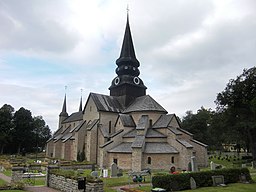Consolidation
History of Sweden between 1060 - 1396
The consolidation of Sweden was a long process during which the loosely organized social system consolidated under the power of the king. Unlike the history of Norway and Denmark, there is no agreement on a reliable date for a "unified Sweden". Historians judge differently the sources for the history of Sweden's consolidation. The earliest history blends with Norse mythology. Early primary sources are foreign; secondary sources were written at a later date.
A common definition of Sweden is that it was formed when the Swedes and Geats were ruled by one king. The names Swedes and Geats are attested in the Old English poems Beowulf (written down in the 11th century) and Widsith (from the 8th century) and building on older legendary and folklore material collected in England. In both poems, an Ongentheow (sw. Angantyr) is named as the King of the Swedes, and the Geats are mentioned as a separate people. These names of peoples having formed in present-day Sweden, the Anglo-Saxon references and now lost tales they were attached to must have travelled across the North Sea. The first king who is considered historical and to have ruled over both peoples, is early 11th century Olof Skötkonung. Broadly speaking, Kings of Sweden, and the nobility of the land, have seen Götaland and Svealand (as well as growing parts of Finland) as equally important parts of the kingdom at least since the mid-13th century and, in some cases, considerably earlier.
Rather than the unification of tribes under one king, others maintain that the process of consolidation was gradual. To solve the problem of defining an early history of Sweden that coincides with reliable sources, a group of modern Swedish historians have contended that a real state could only exist, in the Middle Ages, if had the backing of Christianity and the clergy. The same connection between Christianity and consolidation is used in other countries where written sources are less scarce, such as England or Harald Bluetooth's Denmark. The definition is based on the fact that English and German priests would have brought organizational and administrative skills needed for statehood (including by local rulers). The process of consolidation would have required this important ideological shift. While an Iron Age Germanic king would claim the elective support of his people, and the Norse gods, a crowned Christian king would claim that his rule was divinely inspired. According to this definition the unification should be completed in 1210 when Erik Knutsson was crowned by the church, or perhaps in 1247 when the last separatist rising was defeated at Sparrsätra. A major problem sometimes pointed out with that view is that it entails circular proof: we know next to nothing about how the authority of the ruler was envisaged in heathen times, while we know some more of the Christian ideology of kingship, and obviously the Christian kingdom would underline the break with the pagan past, but this does not really allow the conclusion that there could have been no fixed and religiously connected ideas of the authority of the ruler in pre-Christian times. Moreover, we have no solid testimonies fixing it as a fact that the king residing in Central Sweden (the lake Mälar and Östergötland area) was actually recognized as king in all of the area that was called Sweden by the 13th century, when the mist really clears. There may have existed local kings in Western Sweden, even though their names have not been preserved.
References: Wikipedia
Previous historical period: Viking Age (790-1059) | Next historical period: Kalmar Union (1397-1523)Popular sites founded between 1060 and 1396 in Sweden
Storkyrkan
Stockholm, Sweden
1279
Gamla Stan
Stockholm, Sweden
13th century
Riddarholmen Church
Stockholm, Sweden
ca. 1270-1300
Lund Cathedral
Lund, Sweden
1080-1145
Uppsala Cathedral
Uppsala, Sweden
1287-1435
St. Mary's Church
Helsingborg, Sweden
14th century
St. Lawrence's Church Ruins
Visby, Sweden
1210-1220
Holy Trinity Church
Uppsala, Sweden
1302
St. Catherine's Church Ruins
Visby, Sweden
1250s
Visby Cathedral
Visby, Sweden
1225
St. Peter's Church
Malmö, Sweden
13th century
Kärnan
Helsingborg, Sweden
1310s
St. Clement Church Ruins
Visby, Sweden
13th century
St. Hans' & St. Peter's Church Ruins
Visby, Sweden
13th century
Örebro Castle
Örebro, Sweden
13th century
Holy Spirit Church Ruins
Visby, Sweden
ca. 1200
Härlanda Church Ruins
Gothenburg, Sweden
12th century
Powder Tower
Visby, Sweden
12th century
Linköping Cathedral
Linköping, Sweden
c. 1120
Västerhaninge Church
Haninge, Sweden
13th century
St. Mary's Church
Ystad, Sweden
ca. 1200
Bohus Fortress
Kungälv, Sweden
1308
Visby City Wall
Visby, Sweden
13th century
St. Olof's Church Ruins
Sigtuna, Sweden
ca.1100
